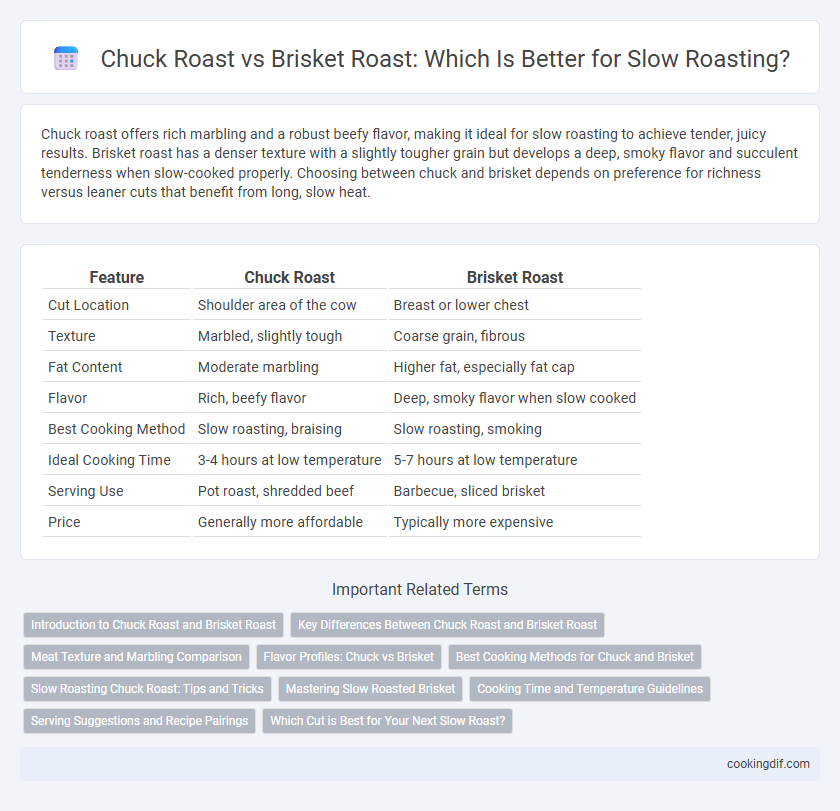Chuck roast offers rich marbling and a robust beefy flavor, making it ideal for slow roasting to achieve tender, juicy results. Brisket roast has a denser texture with a slightly tougher grain but develops a deep, smoky flavor and succulent tenderness when slow-cooked properly. Choosing between chuck and brisket depends on preference for richness versus leaner cuts that benefit from long, slow heat.
Table of Comparison
| Feature | Chuck Roast | Brisket Roast |
|---|---|---|
| Cut Location | Shoulder area of the cow | Breast or lower chest |
| Texture | Marbled, slightly tough | Coarse grain, fibrous |
| Fat Content | Moderate marbling | Higher fat, especially fat cap |
| Flavor | Rich, beefy flavor | Deep, smoky flavor when slow cooked |
| Best Cooking Method | Slow roasting, braising | Slow roasting, smoking |
| Ideal Cooking Time | 3-4 hours at low temperature | 5-7 hours at low temperature |
| Serving Use | Pot roast, shredded beef | Barbecue, sliced brisket |
| Price | Generally more affordable | Typically more expensive |
Introduction to Chuck Roast and Brisket Roast
Chuck roast, cut from the shoulder area of the cow, contains a rich amount of connective tissue and marbling, making it ideal for slow roasting to achieve tender, flavorful meat. Brisket roast, sourced from the breast or lower chest, is known for its dense texture and requires low temperature, long cooking times to break down collagen and develop deep, smoky flavors. Slow roasting both cuts enhances their juiciness and tenderness, but chuck roast generally offers a more concentrated beef flavor due to higher fat content.
Key Differences Between Chuck Roast and Brisket Roast
Chuck roast features more marbling and connective tissue, making it ideal for slow roasting methods that break down collagen into tender, flavorful meat. Brisket roast contains denser muscle fibers and less fat, requiring longer cooking times at low temperatures to achieve a tender texture. The key differences lie in their fat content and muscle structure, impacting both cooking time and final texture during slow roasting.
Meat Texture and Marbling Comparison
Chuck roast features a higher fat content and abundant marbling, resulting in a tender, juicy texture when slow roasted. Brisket roast has a denser muscle structure with moderate marbling, requiring longer cooking times to break down connective tissues and achieve a soft, flavorful bite. Marbling in chuck roast typically enhances moisture retention, while brisket's texture relies more on collagen breakdown for tenderness.
Flavor Profiles: Chuck vs Brisket
Chuck roast offers a rich, beefy flavor with a good balance of marbling and connective tissue, making it ideal for slow roasting to achieve tender, juicy results. Brisket roast, known for its pronounced beefiness and slightly smoky undertone, develops a deep, robust flavor when slow-cooked over low heat for extended periods. Both cuts benefit from slow roasting, but chuck roast typically provides a more balanced flavor profile while brisket delivers a more intense, smoky beef taste.
Best Cooking Methods for Chuck and Brisket
Chuck roast benefits from slow roasting methods such as braising or cooking in a covered Dutch oven to break down its connective tissues and render the meat tender and juicy. Brisket roast excels with low and slow techniques like smoking or using a slow cooker, allowing the collagen to melt and develop rich, smoky flavors over several hours. Both cuts thrive under moist heat and extended cooking times, creating succulent textures ideal for pot roast or barbecue dishes.
Slow Roasting Chuck Roast: Tips and Tricks
Chuck roast is ideal for slow roasting due to its rich marbling and connective tissue, which break down over low heat to create tender, flavorful meat. Maintaining a low temperature around 250degF and cooking for 3 to 4 hours helps achieve optimal tenderness while preserving juiciness. Seasoning with a dry rub and searing the roast before slow cooking enhances the caramelized crust and depth of flavor.
Mastering Slow Roasted Brisket
Mastering slow roasted brisket involves choosing the right cut for optimal tenderness and flavor, with brisket roast offering a rich marbling that breaks down beautifully during long, slow cooking. Unlike the leaner chuck roast, brisket benefits from low temperatures and extended cooking times to achieve its signature melt-in-your-mouth texture and deep, smoky taste. Precise control of heat and moisture ensures the collagen in brisket melts thoroughly, producing a succulent roast prized in barbecue and braising recipes.
Cooking Time and Temperature Guidelines
Chuck roast typically requires a slow roasting temperature of 275degF (135degC) for about 3 to 4 hours to achieve tender, flavorful meat. Brisket roast demands a lower and slower approach at 225degF (107degC), often taking 6 to 8 hours to break down connective tissues fully. Maintaining consistent internal temperatures of 190degF to 205degF ensures optimal tenderness for both cuts during slow roasting.
Serving Suggestions and Recipe Pairings
Chuck roast offers a rich, beefy flavor ideal for slow roasting and pairs excellently with root vegetables like carrots, potatoes, and parsnips, making a hearty pot roast. Brisket roast, known for its tender texture when slow-cooked, complements bold sides such as braised cabbage, coleslaw, and barbecue sauce, popular in Texas-style recipes. Serving chuck roast with robust red wines like Cabernet Sauvignon enhances its depth, while brisket pairs well with smoky, savory accompaniments and medium-bodied beers or dark ales.
Which Cut is Best for Your Next Slow Roast?
Chuck roast, derived from the shoulder, features a rich marbling of fat and connective tissue that melts during slow roasting, producing tender, flavorful meat ideal for pot roasts and stews. Brisket roast, cut from the lower chest, has denser muscle fibers and requires longer cooking times to break down collagen, resulting in a moist, smoky texture perfect for barbecue or braising. Selecting between chuck and brisket depends on desired tenderness and cooking method; chuck is best for quicker slow roasts with juicy results, while brisket excels in extended low-and-slow preparations.
Chuck Roast vs Brisket Roast for slow roasting Infographic

 cookingdif.com
cookingdif.com